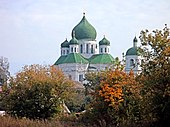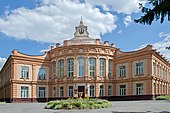Novhorod-Siversky
History
The town was first chronicled in 1044. From 1098 it was the capital of the Siverian Principality, which served as a buffer zone against incursions of the Cumans (Polovtsy) and other steppe peoples. One of the numerous campaigns of local princes against the Cumans produced the great monument of early East Slavic literature, the Tale of Igor's Campaign.
After the town's destruction by Mongols in 1239, it passed to the princes of Bryansk and then to the Grand Dukes of Lithuania. It was ruled by Dymitr Korybut (Kaributas), son of Algirdas. Muscovy obtained the area following the Battle of Vedrosha in 1503, but lost it to Poland after the Time of Troubles, when it submitted to False Dmitry I in the Battle of Novhorod-Siverskyi. Nowogród Siewierski was granted Magdeburg city rights in 1620 by Polish King Sigismund III Vasa. It was the easternmost powiat (county) seat of Poland. The town passed to Russia as a result of the Russo-Polish War (1654–1667). During the Cossack epoch, it received the status of military company town (sotenne misto) and later regimental town (polkove misto); these were military and administrative divisions in the Cossack army and country. Also Novhorod-Siverskyi became a cultural center of Left-bank Ukraine. It was made the capital of a separate namestnichestvo in 1782–97. Thereafter its importance steadily declined.
During World War II, Novhorod-Siverskyi was occupied by the German Army from 26 August 1941 to 16 September 1943.
Until 18 July 2020, Novhorod-Siverskyi was designated as a city of oblast significance and did not belong to Novhorod-Siverskyi Raion even though it was the center of the raion. As part of the administrative reform of Ukraine, which reduced the number of raions of Chernihiv Oblast to four, the city was merged into Novhorod-Siverskyi Raion. During the 24 February 2022 Russian invasion of Ukraine, it was occupied by Russian forces.
Architecture
Despite historic disasters, the town has preserved many architectural monuments, and a branch of the Chernihiv State Historical and Architectural Reserve had been established, which since 1990 has become a separate historical-cultural reserve named after The Tale of Igor's Campaign. The town has managed to maintain random planning in its landscape. The boundary of the town historical center remains vague.
Tourist attractions are located on two high capes divided by ravines: the ensemble of Savior-Transfiguration Monastery and the town centre. The architectural monuments of state significance are scattered on five separate areas which compose the territory of the preserve. The biggest area is the territory of Savior-Transfiguration Monastery. The other areas are Dormition Cathedral, the wooden St. Nicolas Church, a triumphal arch, and shopping arcades.
There are constructions and residential buildings from the 18th and 19th centuries in the town centre. The main point of interest in the town is the former residence of the Chernihiv metropolitans, the monastery of the Saviour's Transfiguration. It features a Neoclassical cathedral (1791–1796, designed by Giacomo Quarenghi), 17th century stone walls, and several ecclesiastic foundations dating from the 16th century. Other landmarks include the Cossack Baroque Assumption Cathedral, a triumphal arch (1787), and the wooden church of St. Nicholas (1760).
Gallery
-
Savior-Transfiguration Monastery. View from the walls of the monastery.
-
Triumphal Arch
-
Savior-Transfiguration Monastery
-
House of seminary
-
Cathedral of the Assumption
-
Savior-Transfiguration Cathedral
-
Women's gymnasium
-
The museum
-
St. Nicholas Church
References
- ^ "Новгород-Северская городская громада" (in Russian). Портал об'єднаних громад України.
- ^ Чисельність наявного населення України на 1 січня 2022 [Number of Present Population of Ukraine, as of January 1, 2022] (PDF) (in Ukrainian and English). Kyiv: State Statistics Service of Ukraine. Archived (PDF) from the original on 4 July 2022.
- ^ "Про утворення та ліквідацію районів. Постанова Верховної Ради України № 807-ІХ". Голос України (in Ukrainian). 18 July 2020. Retrieved 3 October 2020.
- ^ "Нові райони: карти + склад" (in Ukrainian). Міністерство розвитку громад та територій України.
- ^ Yakunina, Oksana (30 May 2022). Тисячолітній Новгород-Сіверський ніколи не здавався, навіть в окупації, - голова громади Людмила Ткаченко [Thousand-years-old Novhorod-Siverskyi never gave up, even during occupation - the head of hromada Liudmyla Tkachenko]. Decentralization.
- ^ Музей-заповідник [Museum-reserve]. Novhorod-Siverksyi museum-reserve "The Tale of Igor's Campaign".
External links
- Novhorod-Siverskyi on the Official Tourism website of Chernihiv Region (in Ukrainian, nice photographs)
- Some of the sites at Podorozh Ukraïnoyu (in Ukrainian, with pictures)
- Forum (in Russian, city info basically copied from the Wikipedia in Russian)
- The murder of the Jews of Novhorod-Siverskyi during World War II, at Yad Vashem website.









